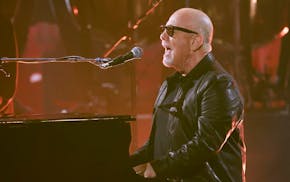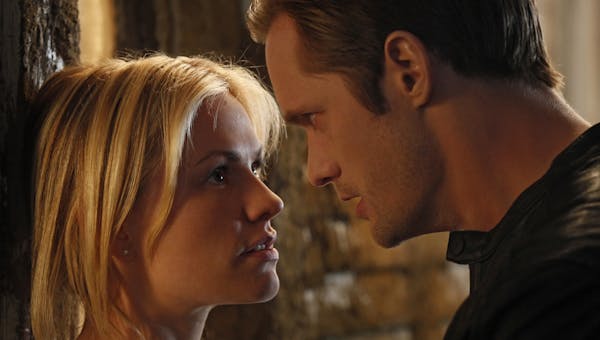Many Minnesotans can recite exactly how many yards Adrian Peterson gathered last season, how many interceptions Christian Ponder threw and how many Big Macs Jared Allen can pound down in one sitting. But when it comes to talking about the original Vikings, a hard-scrambling squad that took the field around 793 A.D., even die-hard fans are bound to fumble the facts.
The History Channel, which traded away the Emmy-winning "The Kennedys" before scoring last year with "Hatfields & McCoys," is betting big that viewers are ready for a proper education. Starting Sunday, the network is investing nine hours and a reported $40 million on "Vikings," the first pop-culture effort to debunk the notion that the medieval Norsemen who invaded Europe and visited America a half-millennium before Christopher Columbus were little more than drunken barbarians who raped and pillaged their way into history.
"The popular cliché is almost completely wrong," said "Vikings" creator Michael Hirst, whose credits include writing the feature film "Elizabeth" and the Showtime series "The Tudors."
Not that the Vikings could be mistaken for pacifists.
Ragnar, whose real-life exploits as an explorer who dared to go west to England is at the heart of this series, is introduced to audiences as a blood-soaked warrior, vanquishing four foes in the North Baltic, then watching as ravens peck at their carcasses. His idea of a romantic line to his wife: "Last night I dreamed you fed me blood pudding, which means you've given me your heart." Cue violins.
Most of his fellow Scandinavians look like they could use a shopping spree at Bed, Bath and Beyond. Their idea of negotiating with the enemy is letting the poor souls decide whether they want to die with an ax to the head or the chest.
But Hirst and his team went to great lengths to present three-dimensional Vikings, ones who were devoted to their gods, families, shipbuilding and even a primitive form of democracy. In one courtroom scene, a murderer is sentenced to death — but not before the attendees raise their hands in unanimous agreement on his guilt.
"Don't get me wrong. They weren't very peaceful men. They didn't say to the English, 'Would you mind awfully much if we came over?' " said George Blagden, who plays a Christian monk, Athelstan, kidnapped by Ragnar. "But there's definitely a more human aspect to their story that hasn't been told before."
Pulling the horns
Some other stereotypes that the series debunks:
• Those horned helmets? Rubbish. This popular image came about because Vikings were buried with their drinking horns, which early archaeologists mistook for part of their attire.
• These Vikings don't hoot and holler as they slay their enemies. According to Clive Standen, who plays Ragnar's hotheaded brother, that would seem childish and a waste of energy. They celebrate when victory is secure.
• Viking women may not have been the inspiration for Ms. magazine, but they could fight alongside men, own property and even divorce.
• The Vikings may have been illiterate, but they were far from stupid. Lena Norrman, who teaches Norse history at the University of Minnesota, points out that Viking boats were engineered to handle heavy seas, thanks to ingenious layering that allowed air to pass through and make the craft more elastic.
Perhaps the most striking visual in the miniseries is that of Ragnar as a strapping, blue-eyed, scruffy-faced figure — a significant contrast to our Minnesota football mascot, who looks like a former ZZ Top roadie who spent too much time in the beer garden.
"I suspect the original Vikings were slim and fit; otherwise they couldn't fit into a ship," Hirst said. "I'm not claiming my Ragnar is what he looked like, but it's closer than the Minneapolis version."
One reason Vikings' history has been as unreliable as a Brett Favre retirement is that much of the documentation came from Christians scornful of the Norsemen's pagan ways, worshiping several gods, including Odin and Thor. (The real Ragnar claimed to be a descendant of Odin.) But Hirst also blames modern culture's lack of interest in proper history, especially here in the States.
"There's a certain laziness in America where you can't be bothered with the facts," he said. "Lots of shows are based on fancy, with this what-the-hell attitude: 'Let's just have lots of special effects.' "
History, written in mud
Hirst doesn't pretend "Vikings" is a documentary, but he has a solid reputation for weaving in as much factual history as he can.
Shortly after writing 1998's "Elizabeth" — a multiple Oscar nominee that gave Cate Blanchett her breakthrough role as the Tudor queen — he started working on a screenplay about Alfred the Great, the king of Wessex who successfully prevented a Vikings conquest. That project didn't go anywhere, but his research paid off when producers started looking for an authentic take on that rarely explored period in world history.
Filming primarily in Ireland (for tax-break purposes), Hirst wound up shooting about 70 percent of the series outdoors, a serious challenge given that region's spotty weather.
"We were shooting a battle while it was pouring rain with five cameras going, 200 extras and 50 horses, all covered in mud," he said. "I thought, 'This is wonderful. This is how it should look.' "
The actors found much of the shoot harrowing, although Standen seemed to be almost salivating as he shared tales from the set.
"Yeah, you get scars on the face and spears coming through shields, but you've got to shrug them off," he said. "If anyone complains, they've signed up for the wrong job."
A bet of biblical proportions
History Channel executives may not have any war wounds, but they're taking a risk of their own.
Expectations are high following the 2012 success of their first scripted project, "Hatfields & McCoys," which earned Emmys for stars Kevin Costner and Tom Berenger and drew more than 14 million viewers. Dirk Hoogstra, History's senior vice president of programming, said "Vikings" doesn't have to put up those kind of numbers, but if it does moderately well, he hopes to turn it into a continuing series.
The only big name in the show is Irish actor Gabriel Byrne ("In Treatment"), and he's largely a supporting player. Hoogstra admits it's hard to get well-known stars to commit to something that might become a series.
On the other hand, the network already has drawn good audiences for documentaries on the Vikings, even without having George Clooney running around in sheepskin trousers.
"From a marketing standpoint, you don't have to do much more than put up a billboard that says 'Vikings,' " said Hoogstra, who is also using this Sunday to launch "The Bible," a docudrama produced by "Survivor" creator Mark Burnett. "Something like this can appeal to someone who's not just a pure history lover. Having an American football team gives it instant brand recognition."
But perhaps Hirst and the History Channel can cry victory only if Ragnar the mascot sees this miniseries and returns next season without the horns — and about 50 pounds lighter.
neal.justin@startribune.com • 612-673-7431 • Twitter: @nealjustin

TV review: 'Jane' is the best heroine for families prepping for Earth Day

CBS will turn the lights back on for Billy Joel concert

TV to watch: Billy Joel offers concert for those of us who aren't big shots

Justin: 10 TV shows about the Founding Fathers that are more fun than Apple's 'Franklin'


